β-Ga2O3 Used as a Saturable Sbsorber to Realize Passively Q-Switched Laser Output
Abstract
:1. Introduction
2. The Preparation and Characterization of β-Ga2O3
3. Experimental Results and Discussion
4. Conclusions
Author Contributions
Funding
Institutional Review Board Statement
Data Availability Statement
Acknowledgments
Conflicts of Interest
References
- Namour, M.; Mobadder, M.; Magnin, D.; Peremans, A.; Verspecht, T.; Teughels, W.; Lamard, L.; Nammour, S.; Rompen, E. Q-Switch Nd:YAG laser-assisted decontamination of implant surface. Dent. J. 2019, 7, 99. [Google Scholar] [CrossRef] [Green Version]
- Namour, M.; Verspecht, T.; Mobadder, M.; Teughels, W.; Peremans, A.; Nammour, S.; Rompen, E. Q-Switch Nd:YAG laser-assisted elimination of multi-species biofilm on titanium surfaces. Materials 2020, 13, 1573. [Google Scholar] [CrossRef] [PubMed] [Green Version]
- Cong, Z.; Liu, Z.; Qin, Z.; Zhang, X.; Wang, S.; Rao, H.; Fu, Q. RTP Q-switched single-longitudinal-mode Nd:YAG laser with a twisted-mode cavity. Appl. Opt. 2015, 54, 5143–5146. [Google Scholar] [CrossRef] [PubMed] [Green Version]
- Suzuki, M.; Boyraz, O.; Asghari, H.; Jalali, B. Spectral dynamics on saturable absorber in mode-locking with time stretch spectroscopy. Sci. Rep. 2020, 10, 14460. [Google Scholar] [CrossRef]
- Ren, C.; Deng, X.; Hu, W.; Li, J.; Miao, X.; Xiao, S.; Liu, H.; Fan, Q.; Wang, K.; He, T. A near-infrared I emissive dye: Toward the application of saturable absorber and multiphoton fluorescence microscopy at the deep-tissue imaging window. Chem. Commun. (Camb.) 2019, 25, 5111–5114. [Google Scholar] [CrossRef] [PubMed]
- Gerislioglu, B.; Bakan, G.; Ahuja, R.; Adam, J.; Mishra, Y.K.; Ahmadivand, A. The role of Ge2Sb2Te5 in enhancing the performance of functional plasmonic devices. Mater. Today Phys. 2020, 12, 100178. [Google Scholar] [CrossRef]
- Wang, M.; Zheng, Y.; Guo, L.; Chen, X.; Zhang, H.; Li, D. Nonlinear optical properties of zirconium diselenide and its ultra-fast modulator application. Nanomaterials 2019, 9, 1419. [Google Scholar] [CrossRef] [Green Version]
- Yang, J.; Tian, K.; Li, Y.; Dou, X.; Ma, Y.; Han, W.; Xu, H.; Liu, J. Few-layer Bi2Te3: An effective 2D saturable absorber for passive Q-switching of compact solid-state lasers in the 1-μm region. Opt. Express 2018, 26, 21379–21389. [Google Scholar] [CrossRef]
- Ge, W.; Zhang, H.; Wang, J.; Cheng, X.; Jiang, M.; Du, C.; Yuan, S. Pulsed laser output of LD-end-pumped 1.34 mum Nd:GdVO4 laser with Co:LaMgAl11O19 crystal as saturable absorber. Opt. Express 2005, 13, 3883–3889. [Google Scholar] [CrossRef]
- Malinauskas, M.; Žukauskas, A.; Hasegawa, S.; Hayasaki, Y.; Mizeikis, V.; Buividas, R.; Juodkazis, S. Ultrafast laser processing of materials: From science to industry. Light Sci. Appl. 2016, 5, 16133. [Google Scholar] [CrossRef] [Green Version]
- Kouno, A.; Watanabe, S.; Hongo, T.; Yao, K.; Satake, K.; Okiji, T. Effect of pulse energy, pulse frequency, and tip diameter on intracanal vaporized bubble kinetics and apical pressure during laser-activated irrigation using Er:YAG Laser. Photomed. Laser Surg. 2020, 38, 431–437. [Google Scholar] [CrossRef]
- Ge, Z.; Saito, T.; Kurose, M.; Kanda, H.; Arakawa, K.; Takeda, M. Precision interferometry for measuring wavefronts of multi-wavelength optical pickups. Opt. Express 2008, 16, 133–143. [Google Scholar] [CrossRef]
- Griffith, R.; Simmons, B.; Bray, F.; Falto-Aizpurua, L.; Abyaneh, M.; Nouri, K. 1064 nm Q-switched Nd:YAG laser for the treatment of Argyria: A systematic review. J. Eur. Acad. Dermatol. Venereol. 2015, 29, 2100–2103. [Google Scholar] [CrossRef]
- Chang, Y.; Lee, J.; Jhon, Y.; Lee, J. Active Q-switching in an erbium-doped fiber laser using an ultrafast silicon-based variable optical attenuator. Opt. Express 2011, 19, 26911–26916. [Google Scholar] [CrossRef] [PubMed]
- Cabalín, L.; González, A.; Lazic, V.; Laserna, J. Deep ablation and depth profiling by laser-induced breakdown spectroscopy (LIBS) employing multi-pulse laser excitation: Application to galvanized steel. Appl. Spectrosc. 2011, 65, 797–805. [Google Scholar] [CrossRef] [PubMed]
- Kim, S.; Lee, H.; Oh, S.; Noh, B.; Park, S.; Im, Y.; Son, S.; Song, Y.; Kim, K. Transparent conductive electrodes of β-Ga2O3;/Ag/β-Ga2O3; multilayer for ultraviolet emitters. J. Nanosci. Nanotechnol. 2019, 19, 6328–6333. [Google Scholar] [CrossRef]
- An, Y.; Shen, X.; Hao, Y.; Guo, P.; Tang, W. Enhanced resistance switching of Ga2O3 thin films by ultraviolet radiation. J. Nanosci. Nanotechnol. 2020, 20, 3283–3286. [Google Scholar] [CrossRef] [PubMed]
- Ma, J.; Yoo, G. Electrical properties of top-gate β-Ga2O3 nanomembrane metal-semiconductor field-effect transistor. J. Nanosci. Nanotechnol. 2020, 20, 516–519. [Google Scholar] [CrossRef]
- Bae, H.; Yoo, T.; Yoon, Y.; Lee, I.; Kim, J.; Cho, B.; Hwang, W. High-aspect ratio β-Ga2O3 nanorods via hydrothermal synthesis. Nanomaterials 2018, 8, 594. [Google Scholar] [CrossRef] [Green Version]
- Long, X.; Niu, W.; Wan, L.; Chen, X.; Cui, H.; Sai, Q.; Xia, C.; Devki, N.T.; Feng, Z. Optical and Electronic Energy Band Properties of Nb-Doped β-Ga2O3 crystals. Crystals 2021, 11, 135. [Google Scholar] [CrossRef]
- Hisatomi, T.; Brillet, J.; Cornuz, M.; Le Formal, F.; Tétreault, N.; Sivula, K.; Grätzel, M.A. Ga2O3 underlayer as an isomorphic template for ultrathin hematite films toward efficient photoelectrochemical water splitting. Faraday Discuss. 2012, 155, 223–232. [Google Scholar] [CrossRef]
- Zhou, H.; Zeng, S.; Zhang, J.; Liu, Z.; Feng, Q.; Xu, S.; Zhang, J.; Hao, Y. Comprehensive Study and Optimization of Implementing p-NiO in β-Ga2O3 Based Diodes via TCAD Simulation. Crystals 2021, 11, 1186. [Google Scholar] [CrossRef]
- Reddy, L.; Ko, Y.; Yu, J. Hydrothermal synthesis and photocatalytic property of β-Ga2O3 nanorods. Nanoscale Res. Lett. 2015, 10, 364. [Google Scholar] [CrossRef] [Green Version]
- Huan, Y.; Sun, S.; Gu, C.; Liu, W.; Ding, S.; Yu, H.; Xia, C.; Zhang, D. Recent advances in β-Ga2O3-Metal contacts. Nanoscale Res. Lett. 2018, 13, 246. [Google Scholar] [CrossRef]
- Cui, W.; Ren, Q.; Zhi, Y.; Zhao, X.; Wu, Z.; Li, P.; Tang, W. Optimization of growth temperature of β-Ga2O3 thin films for solar-blind photodetectors. J. Nanosci. Nanotechnol. 2018, 18, 3613–3618. [Google Scholar] [CrossRef]
- Yeom, T.; Lim, A. Study of nuclear quadrupole interactions and quadrupole Raman processes of 69Ga and 71Ga in a β-Ga2O3:Cr3+ single crystal. J. Magn. Reson. 2009, 200, 261–266. [Google Scholar] [CrossRef]
- Xue, H.; He, Q.; Jian, G.; Long, S.; Pang, T.; Liu, M. An overview of the ultrawide bandgap Ga2O3 Semiconductor-Based schottky barrier diode for power electronics application. Nanoscale Res. Lett. 2018, 13, 290. [Google Scholar] [CrossRef] [Green Version]
- Hoshikawa, K.; Kobayashi, T.; Ohba, E.; Kobayashi, T. 50mm diameter Sn-doped (001) β-Ga2O3 crystal growth using the Vertical Bridegman Technique in ambient air. J. Cryst. Growth 2020, 546, 125778. [Google Scholar] [CrossRef]
- Abbene, L.; Principato, F.; Gerardi, G.; Buttacavoli, A.; Cascio, D.; Bettelli, M.; Amadè, N.; Seller, P.; Veale, M.; Fox, O.; et al. Room-temperature X-ray response of cadmium-zinc-telluride pixel detectors grown by the vertical Bridgman technique. J. Synchrotron Radiat. 2020, 27, 319–328. [Google Scholar] [CrossRef] [PubMed] [Green Version]
- Kozhemyakin, G.; Nemets, L.; Bulankina, A. Simulation of ultrasound influence on melt convection for the growth of GaxIn1−xSb and Si single crystals by the Czochralski method. Ultrasonics 2014, 54, 2165–2168. [Google Scholar] [CrossRef] [PubMed]
- Zhou, H.; Zhu, S.; Li, Z.; Yin, H.; Zhang, P.; Chen, Z.; Fu, S.; Zhang, Q.; Lv, Q. Investigation on 1.0 and 1.3 µm laser performance of Nd3+: GYAP crystal. Opt. Laser Technol. 2019, 119, 105601. [Google Scholar] [CrossRef]
- Sun, X.; Nie, H.; He, J.; Zhao, R.; Su, X.; Wang, Y.; Zhang, B.; Wang, R.; Yang, K. Passively mode-locked 1.34 µm bulk laser based on few-layer black phosphorus saturable absorber. Opt. Express 2017, 25, 20025–20032. [Google Scholar] [CrossRef]
- Fan, M.; Li, T.; Zhao, S.; Li, G.; Ma, H.; Gao, X.; Kränkel, C.; Huber, G. Watt-level passively Q-switched Er:Lu2O3 laser at 2.84 m using MoS2. Opt. Lett. 2016, 41, 540–543. [Google Scholar] [CrossRef]
- Zhu, H.; Chen, Y.; Lin, Y.; Gong, X.; Luo, Z.; Huang, Y. Efficient quasi-continuous-wave and passively Q-switched laser operation of a Nd3+:BaGd2(MoO4)4 cleavage plate. Appl. Opt. 2008, 47, 531–535. [Google Scholar] [CrossRef] [PubMed]
- Yao, B.; Yuan, J.; Li, J.; Dai, T.; Duan, X.; Shen, Y.; Cui, Z.; Pan, Y. High-power Cr2+:ZnS saturable absorber passively Q-switched Ho:YAG ceramic laser and its application to pumping of a mid-IR OPO. Opt. Lett. 2015, 40, 348–351. [Google Scholar] [CrossRef]
- Li, P.; Li, Y.; Sun, Y.; Hou, X.; Zhang, H.; Wang, J. Passively Q-switched 1.34 mum Nd:YxGd(1−x)VO(4) laser with Co2+:LaMgAl(11)O(19) saturable absorber. Opt. Express 2006, 14, 7730–7736. [Google Scholar] [CrossRef] [PubMed]
- Huang, H.T.; He, J.L.; Zhang, B.T.; Yang, J.F.; Xu, J.L.; Zuo, C.H.; Tao, X.T. V3+:YAG as the saturable absorber for a diode-pumped quasi-three-level dual-wavelength Nd:GGG laser. Opt. Express 2010, 18, 3352–3357. [Google Scholar] [CrossRef]
- Kharazmi, A.; Faraji, N.; Mat Hussin, R.; Saion, E.; Yunus, W.M.; Behzad, K. Structural, optical, opto-thermal and thermal properties of ZnS-PVA nanofluids synthesized through a radiolytic approach. Beilstein J. Nanotechnol. 2015, 6, 529–536. [Google Scholar] [CrossRef] [Green Version]
- Guo, Z.; Verma, A.; Wu, X.F.; Sun, F.Y.; Hickman, A.; Masui, T.; Kuramata, A.; Higashiwaki, M.; Jena, D.; Luo, T.F. Anisotropic thermal conductivity in single crystal β-gallium oxide. Appl. Phys. Lett. 2015, 106, 1–5. [Google Scholar] [CrossRef]
- Sun, J.B.; Niu, L.F.; Hui, Y.L.; Chen, W.Y.; Wang, X.L.; Lu, J.S.; Wei, H. Thermal conductivity and compatibility of LaMgAl11O19/LaPO4 composites. Ceram. Int. 2020, 46, 27967–27972. [Google Scholar] [CrossRef]
- Li, P.; Bu, Y.; Chen, D.; Sai, Q.; Qi, H. Investigation of the crack extending downward along the seed of the β-Ga2O3 crystal grown by the EFG method. CrystEngComm 2021, 23, 6300–6306. [Google Scholar] [CrossRef]
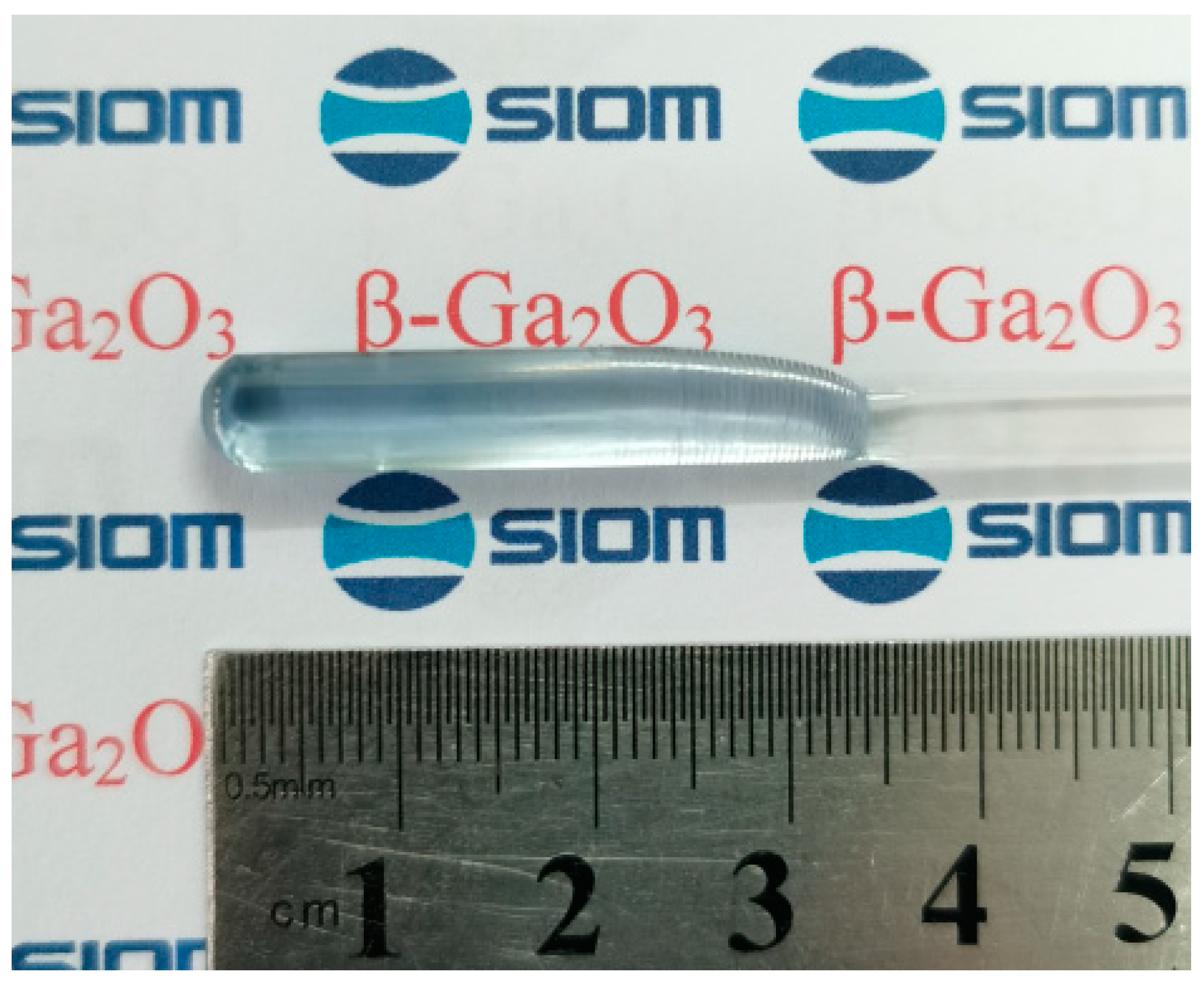

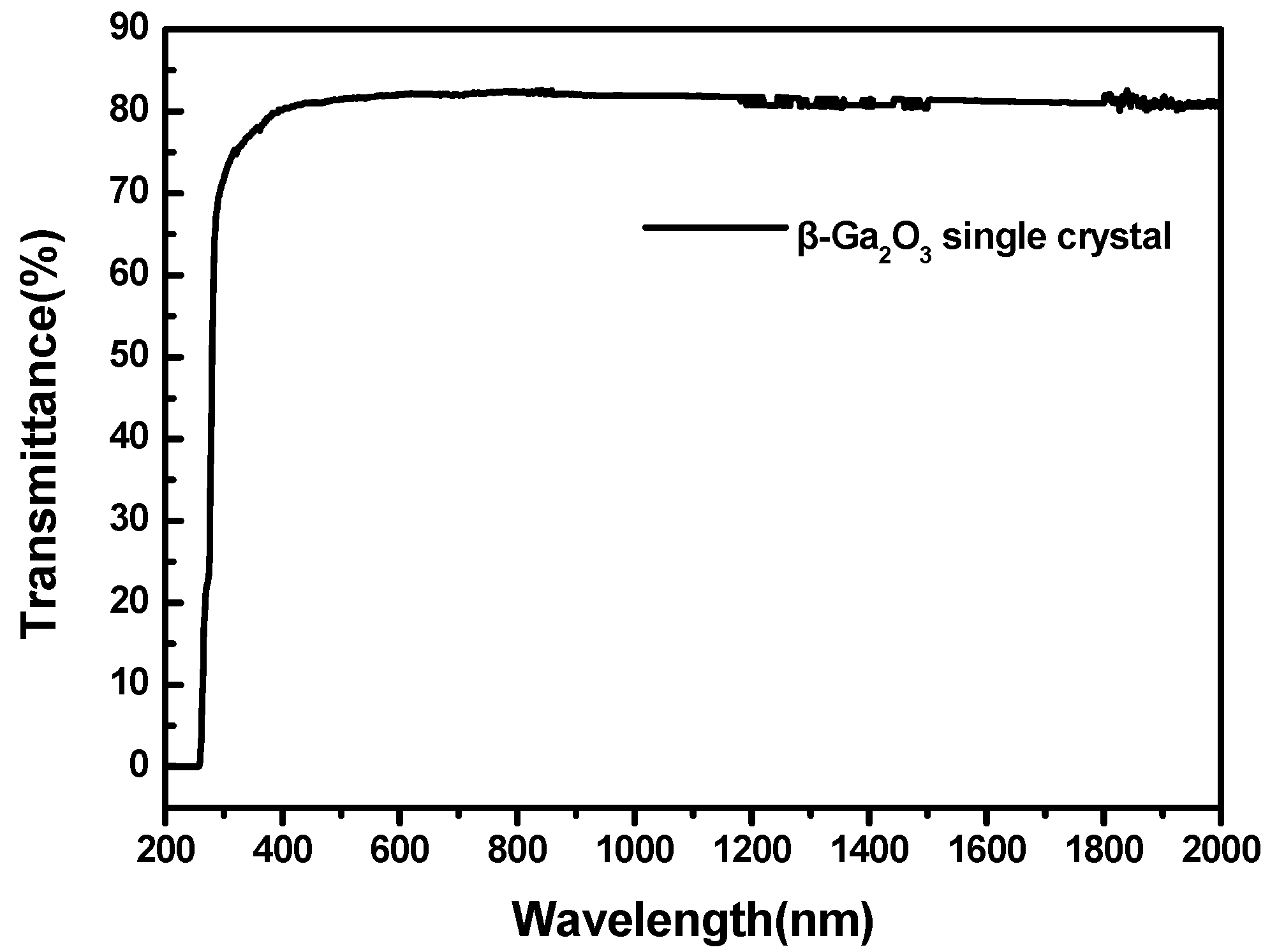

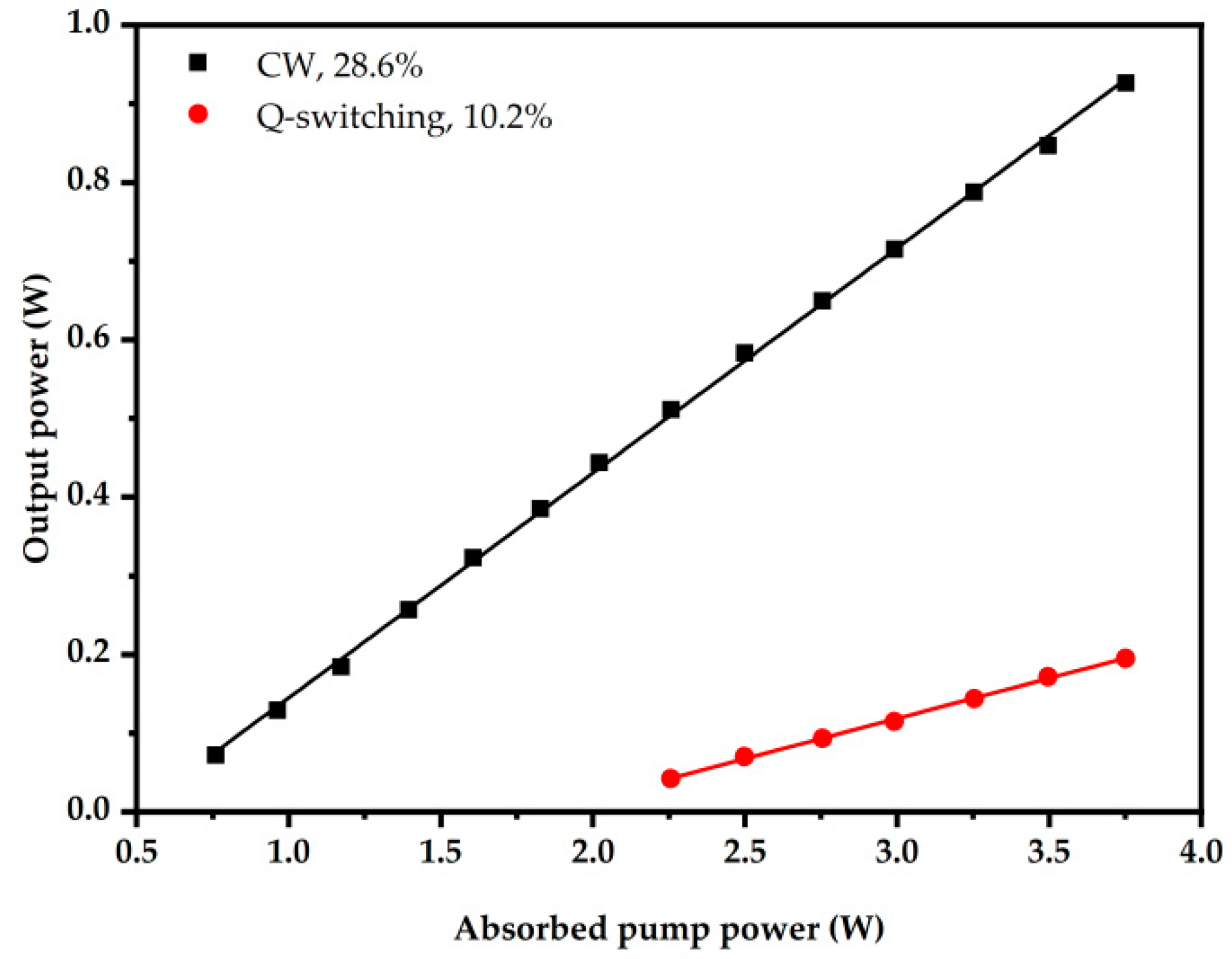
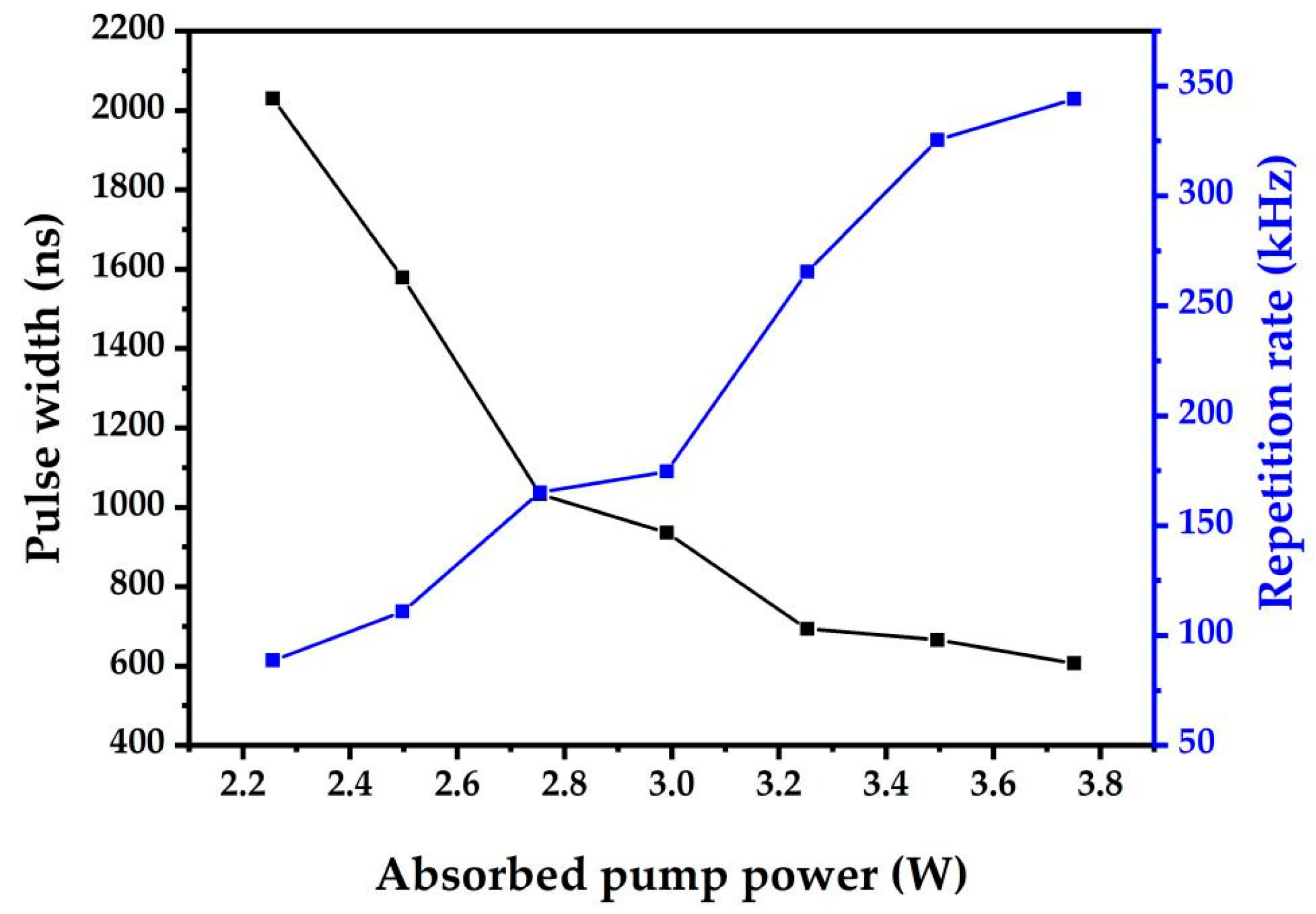
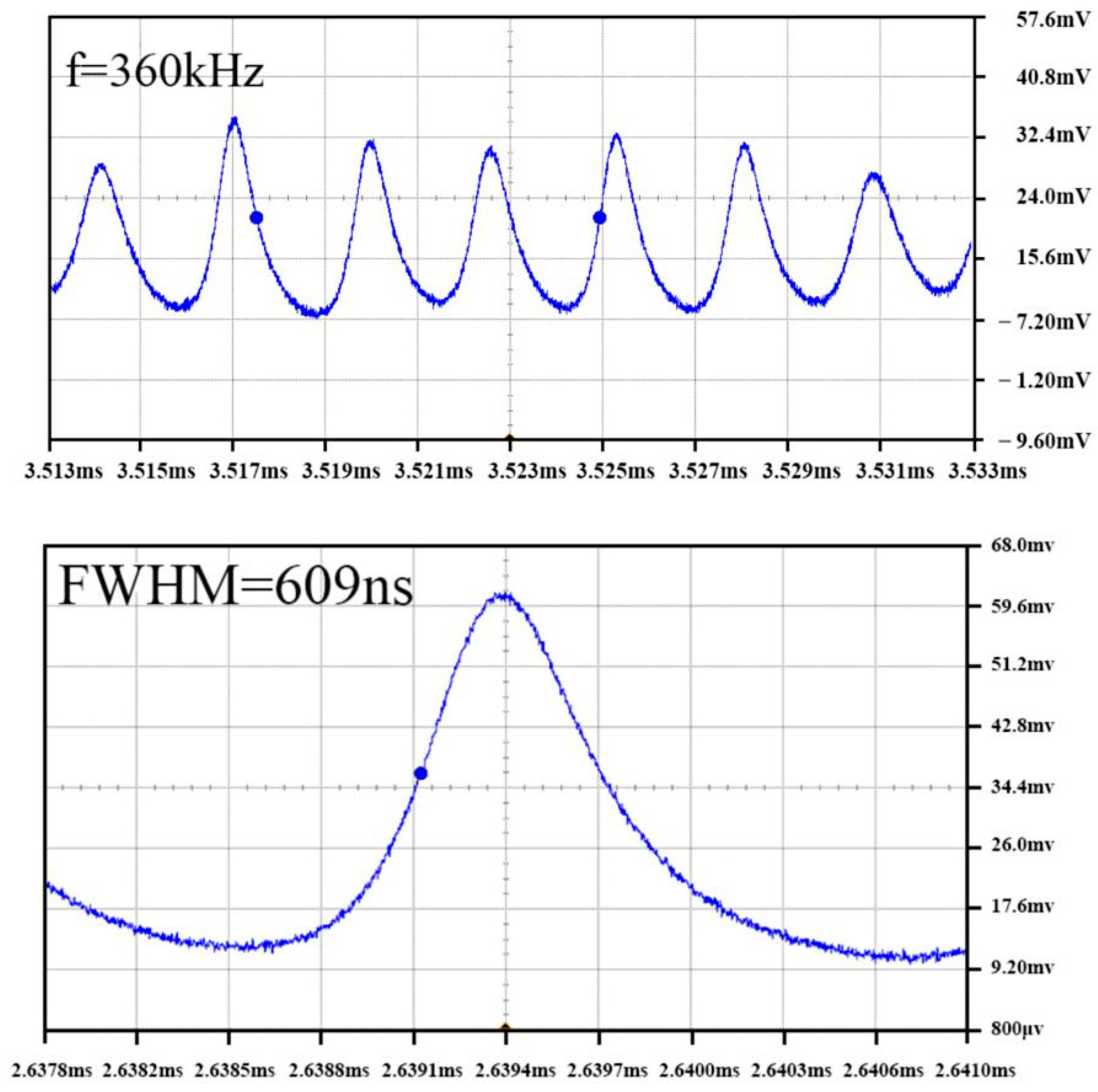
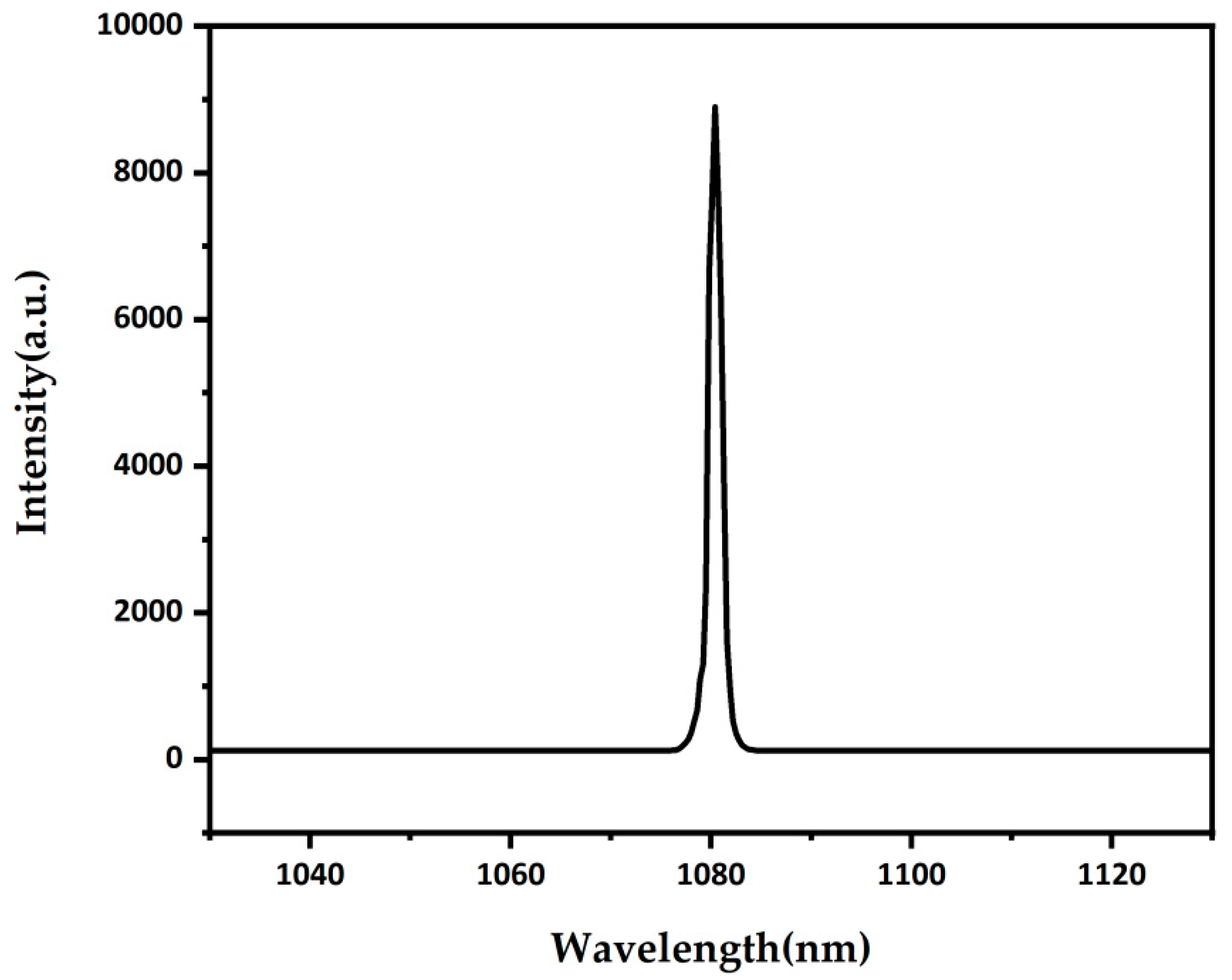
Publisher’s Note: MDPI stays neutral with regard to jurisdictional claims in published maps and institutional affiliations. |
© 2021 by the authors. Licensee MDPI, Basel, Switzerland. This article is an open access article distributed under the terms and conditions of the Creative Commons Attribution (CC BY) license (https://creativecommons.org/licenses/by/4.0/).
Share and Cite
Li, B.; Chen, Q.; Zhang, P.; Tian, R.; Zhang, L.; Sai, Q.; Wang, B.; Pan, M.; Liu, Y.; Xia, C.; et al. β-Ga2O3 Used as a Saturable Sbsorber to Realize Passively Q-Switched Laser Output. Crystals 2021, 11, 1501. https://doi.org/10.3390/cryst11121501
Li B, Chen Q, Zhang P, Tian R, Zhang L, Sai Q, Wang B, Pan M, Liu Y, Xia C, et al. β-Ga2O3 Used as a Saturable Sbsorber to Realize Passively Q-Switched Laser Output. Crystals. 2021; 11(12):1501. https://doi.org/10.3390/cryst11121501
Chicago/Turabian StyleLi, Baizhong, Qiudi Chen, Peixiong Zhang, Ruifeng Tian, Lu Zhang, Qinglin Sai, Bin Wang, Mingyan Pan, Youchen Liu, Changtai Xia, and et al. 2021. "β-Ga2O3 Used as a Saturable Sbsorber to Realize Passively Q-Switched Laser Output" Crystals 11, no. 12: 1501. https://doi.org/10.3390/cryst11121501
APA StyleLi, B., Chen, Q., Zhang, P., Tian, R., Zhang, L., Sai, Q., Wang, B., Pan, M., Liu, Y., Xia, C., Chen, Z., & Qi, H. (2021). β-Ga2O3 Used as a Saturable Sbsorber to Realize Passively Q-Switched Laser Output. Crystals, 11(12), 1501. https://doi.org/10.3390/cryst11121501




